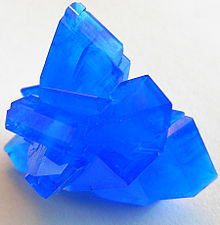Crystallography
Crystallography is the science that studies crystals. Most minerals, organic compounds and numerous materials adopt crystalline structures when favorable conditions have occurred. Originally, the study of crystallography included the study of the growth and external geometry of these crystals, later moving on to the study of their internal structure and their chemical composition. Internal structure studies rely heavily on the analysis of patterns of diffraction arising from a crystalline sample when irradiated with a beam of X-rays, neutrons, or electrons. The crystalline structure can also be studied by means of electron microscopy. One of its objectives is to know the relative position of the atoms, ions and molecules that constitute them and their repetition or packing patterns, that is, their three-dimensional structure.
The arrangement of atoms in a crystal can be known by diffraction of X-rays, neutrons or electrons. Crystallographic chemistry studies the relationship between chemical composition, the arrangement of atoms, and the bonding forces between them. This relationship determines physical and chemical properties of minerals.
When conditions are favourable, each element or chemical compound tends to crystallize in a defined and characteristic way. Thus, common salt tends to form cubic crystals, while garnet, which sometimes also forms cubes, is more frequently found in dodecahedrons or triakisoctahedrons. Despite their different forms of crystallization, salt and garnet always crystallize in the same class and system.
Thirty-two crystal classes are theoretically possible, but only a dozen include virtually all common minerals, and some classes have never been observed. These thirty-two classes are grouped into six crystalline systems, characterized by the length and position of their axes. The minerals in each system share some characteristics of symmetry and crystalline form, as well as many important optical properties.
Crystallography is an important technique in several scientific disciplines, including chemistry, physics, and biology, and has numerous practical applications in medicine, mineralogy, and the development of new materials. For its role in "coping with challenges such as disease and environmental problems", UNESCO declared 2014 the International Year of Crystallography.
Origin of name
The first use of the term crystallography related to the study of crystals is due to the Swiss physician and iatrochemist Moritz Anton Cappeller (1685-1769), who used it in 1723 in his work Prodromus crystallographiae de crystallis improprie sic dictis commentarium .
Theory
A crystalline material is one in which the atoms are structured in networks based on the three-dimensional repetition of their components. The repeating structure is called a unit cell. Crystals are classified based on the symmetry properties of the unit cell. These symmetry properties are also sometimes manifested in macroscopic symmetries of crystals, such as geometric shapes or fracture planes. The study of crystallography requires some knowledge of the symmetry group.
Elements of symmetry
The fundamental cells of a crystal present elements of symmetry, which are:
- Axis of symmetry: It is an imaginary line that passes through the glass, around which, by making this a complete twist, repeats twice or more times the same aspect. The shafts can be: monaries, if they rotate the motif once (360°); binary, if they rotate twice (180°); ternaries, if they rotate it three times (120°); quaternaries, if they rotate it four times (90°); or senarios, if they rotate the motif six times (60°).
- Symmetry Plan: It is an imaginary plane that divides the crystal into two symmetrical speculare halves, such as the reflection in a mirror, inside the cell. There may be multiple planes of symmetry. It is represented with the letter m.
- Symmetry Center: It is a point within the cell that, by joining it with any of the surface, repeats on the other side of the center and at the same distance a similar point.
- Crystal systems: all crystalline networks, like crystals, which are a consequence of networks, present elements of symmetry. If the 230 spatial groups are classified according to the symmetry elements they possess, 32 kinds of symmetry are obtained (each of which gathers all the crystalline forms that possess the same elements of symmetry) that is, regular or cubic, tetragonal, hexagonal, rhomboic, rhombic, monoclinic and trilinic.
Types of crystalline habit
The habit is the external appearance of the crystal, the different types of habit depend on the structure of the mineral and the external conditions in which they are formed, they are:
- Crystal Habits: is the appearance of a crystal as a result of the different development of their faces.
- Headphone: crystals with great development of vertical faces. They look like needles.
- Hábito hojoso: crystals with leaves look for the great development of the horizontal faces.
Crystallographic forms
It is the set of equal faces that are related by their symmetry:
- One face: paedo
- Two faces:
- Pinacoid: equal and parallel related by a binary plane or axis.
- Dome: non-parallel that relate to a plane.
- Esphenoid: not parallel related by a binary axis.
- Prismas, pyramids, pyramids, rags, Bathing ladder.
- Crystal class.
The possible groupings of symmetry elements in crystals are only thirty-two, which, in turn, are grouped into the so-called seven crystalline systems (cubic, tetragonal, hexagonal, trigonal or rhombohedral, orthorhombic, monoclinic, and triclinic).
Properties
- Trilinnic system (aerobic) α α {displaystyle alpha }I was.β β {displaystyle beta }I was.γ γ {displaystyle gamma }90°): has no minimum symmetry.
- Monoclinic system (aerobic) α α {displaystyle alpha }=γ γ {displaystyle gamma }=90°β β {displaystyle beta }90°): Presents as a minimum symmetry a binary rotation axis or a binary investment axis (=symmetry plan)
- Orthrombic system (aerobic) α α {displaystyle alpha }=β β {displaystyle beta }=γ γ {displaystyle gamma }=90°): At least it has three perpendicular binary axes.
- Tetragonal system (a=bìc α α {displaystyle alpha }=β β {displaystyle beta }=γ γ {displaystyle gamma }=90°): possesses as a fundamental characteristic a quaternary rotation axis or a quaternary investment axis.
- Hexagonal system (a=bìc α α {displaystyle alpha }=β β {displaystyle beta }=90°, γ γ {displaystyle gamma }=120°): its fundamental characteristic is the presence of a sensary rotation axis or a sensary investment axis (ternaryaxis + perpendicular symmetry plane). For greater accuracy, a fourth axis is usually introduced i, coplanar with a and b, which forms an angle of 120° with each one of them, so the axial cross will be (a=b=iec α α {displaystyle alpha }=β β {displaystyle beta }=90°, γ γ {displaystyle gamma }=120°).
- Hexagonal Miller Indices: As a fourth index works, which stands at a1-2 and 120° level of each of these axes, hexagonal planes are to be represented by four indexes (hkil). The i value is determined as -(h+k).
- Romboiric or trigonal system (a=b=c α α {displaystyle alpha }=β β {displaystyle beta }=γ γ {displaystyle gamma }90°): its common feature is the presence of a ternary rotation axis or a ternary investment axis (ternaryaxis + symmetry center).
- Cubic system (a=b=c α α {displaystyle alpha }=β β {displaystyle beta }=γ γ {displaystyle gamma }=90°): possesses as a fundamental characteristic four axes of ternary rotation inclined to 109.47°.
Methods
Crystallographic methods rely heavily on the analysis of diffraction patterns that arise from a crystalline sample when irradiated with a beam of X-rays, neutrons, or electrons. The crystalline structure can also be studied by means of electron microscopy.
Crystallography in biology
X-ray assisted crystallography is the main method of obtaining structural information in the study of proteins and other organic macromolecules (such as the DNA double helix, whose shape was identified in X-ray diffraction patterns). The analysis of such complex molecules and, especially, those with little symmetry requires a very complex analysis, using computers so that the proposed molecular model and crystal packing are consistent with the experimental diffraction pattern. The Protein Data Bank (PDB) contains structural information on proteins and other biological macromolecules.
Crystallography in materials engineering
The properties of crystalline materials largely depend on their crystalline structure. Engineering materials are generally polycrystalline materials. Just as the properties of the single crystal are given by the characteristics of the atoms of the material, the properties of the polycrystals are determined by the characteristics and the spatial orientation of the crystals that compose it.
The X-ray diffraction technique allows studying the structure of the single crystal by identifying the diffracting planes according to Bragg's law, which is useful for phase determination. In addition, crystallographic methods also allow studying the distribution of crystallographic orientations in a material, also known as crystallographic texture.
Contenido relacionado
Chemical compound
Maltase
Humanities





